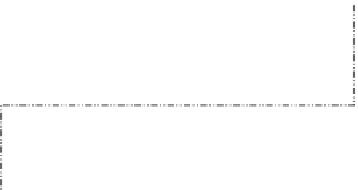Environmental Engineering Reference
In-Depth Information
Indeed, end-consumer choices in relation to type (e.g. small, medium or large) and
location of retail outlet undoubtedly impact on freight distribution flows: the
characteristics of the restocking process are strictly related to the type of retail
activities to be restocked in terms of delivery size, delivery frequency, freight
vehicle type and so on. For example, delivery size and freight vehicle size tend to
increase with the size of retail activities, while delivery frequency tends to
decrease, with considerable effect on the total distance travelled by freight vehi-
cles. Therefore, end-consumer choices among small, medium and large retail
outlets affect restocking characteristics and the total freight vehicle distance
travelled.
In this context, a new city logistics scenario, implemented to improve urban
sustainability and reduce the negative impacts of these two freight transport
components, can affect one of the two components with effects on the other, too.
Therefore, a study of urban freight transport and the relative methodology to assess
a city logistics scenario should consider both components jointly and that freight
transport is mainly generated by the requirement of end consumers to satisfy their
needs for goods and services. Therefore, a joint modeling framework that con-
siders both shopping and restocking flows (in terms of quantity, delivery, tour and
vehicle) is desirable. The complete framework of such a modeling system
developed by the authors in the course of multi-year research is reported below.
4.1 The Integrated Modeling Framework
The integrated modeling framework consists of various steps (Fig.
2
):
• shopping trip models; these allow us to simulate the end consumer's shopping
behavior and estimate the freight flows attracted by each traffic zone; this step
allows us to point out the effects of implementing long-term action (e.g. urban
land-use governance) on the location of retail establishments and place of res-
idence; at the tactical or operational level such models can assess the effects on
the choices of type and location of shops for purchasing goods and the transport
mode used;
shopping
restocking
SHOPPING O-D FLOWS
per retail outlet type
and mode
QUANTITY O-D
RESTOCKING FLOWS
SHOPPING
QUANTITY
VEHICLE O-D
RESTOCKING FLOWS
DELIVERY O-D
RESTOCKING FLOWS
VEHICLE/TOUR
DELIVERY
model
data
Fig. 2
Urban freight modeling structure






























Search WWH ::

Custom Search